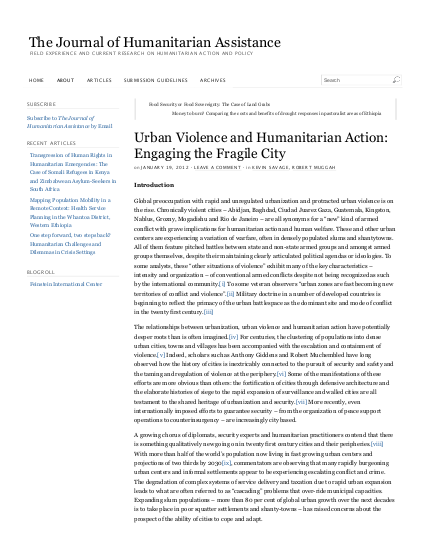
Global preoccupation with rapid and unregulated urbanization and protracted urban violence is on the rise. Chronically violent cities – Abidjan, Baghdad, Ciudad Juarez Gaza, Guatemala, Kingston, Nablus, Grozny, Mogadishu and Rio de Janeiro – are all synonyms for a “new” kind of armed conflict with grave implications for humanitarian action and human welfare. These and other urban centers are experiencing a variation of warfare, often in densely populated slums and shantytowns. All of them feature pitched battles between state and non-state armed groups and amongst armed groups themselves, despite their maintaining clearly articulated political agendas or ideologies. To some analysts, these “other situations of violence” exhibit many of the key characteristics – intensity and organization – of conventional armed conflicts despite not being recognized as such by the international community.[i] To some veteran observers “urban zones are fast becoming new territories of conflict and violence”.[ii] Military doctrine in a number of developed countries is beginning to reflect the primacy of the urban battlespace as the dominant site and mode of conflict in the twenty first century.[iii]
The relationships between urbanization, urban violence and humanitarian action have potentially deeper roots than is often imagined.[iv] For centuries, the clustering of populations into dense urban cities, towns and villages has been accompanied with the escalation and containment of violence.[v] Indeed, scholars such as Anthony Giddens and Robert Muchembled have long observed how the history of cities is inextricably connected to the pursuit of security and safety and the taming and regulation of violence at the periphery.[vi] Some of the manifestations of these efforts are more obvious than others: the fortification of cities through defensive architecture and the elaborate histories of siege to the rapid expansion of surveillance and walled cities are all testament to the shared heritage of urbanization and security.[vii] More recently, even internationally imposed efforts to guarantee security – from the organization of peace support operations to counterinsurgency – are increasingly city based.
A growing chorus of diplomats, security experts and humanitarian practitioners contend that there is something qualitatively new going on in twenty first century cities and their peripheries.[viii] With more than half of the world’s population now living in fast growing urban centers and projections of two thirds by 2030[ix], commentators are observing that many rapidly burgeoning urban centers and informal settlements appear to be experiencing escalating conflict and crime. The degradation of complex systems of service delivery and taxation due to rapid urban expansion leads to what are often referred to as “cascading” problems that over-ride municipal capacities. Expanding slum populations – more than 80 per cent of global urban growth over the next decades is to take place in poor squatter settlements and shanty-towns – has raised concerns about the prospect of the ability of cities to cope and adapt. This paper sets out the broad parameters of urban violence in the twenty first century and why this matters for the humanitarian community. It first describes key trends in urbanization and urban violence and the problematic assumptions linking the two. This opening section also considers recent contributions from the urban sociology and human geography literatures. The second section reflects on the humanitarian challenges arising from protracted urban violence. While far from exhaustive, it makes the case for a more comprehensive engagement in such settings by the relief and development sectors. The paper concludes with a number of reflections on how humanitarian agencies are already starting to engage with urban settings – including perceived opportunities and challenges.
Links
Resource collections
- UN Habitat - Urban Response Collection
- Urban Response - Urban Crisis Preparedness and Risk Reduction
- Urban Response Collection - Community Engagement and Social Cohesion
- Urban Response Collection - Economic Recovery
- Urban Response Collection - Environment and Climate Change
- Urban Response Collection - Housing, Land and Property
- Urban Response Collection - Urban Crisis Response, Recovery and Reconstruction
- Urban Response Collection - Urban Resilience